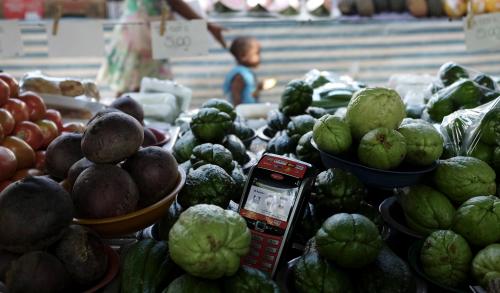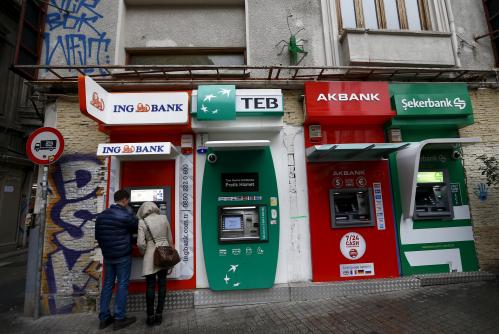On August 4, the Brookings Financial and Digital Inclusion Project (FDIP) team launched the findings of the second annual FDIP report. The report highlights developments within the financial inclusion ecosystems of 26 diverse countries from spring 2015 through spring 2016. In this post, the FDIP team explores a number of advances within the financial inclusion landscape of one of its focus countries, Mexico, since the end of the data collection period for the 2016 FDIP Report.
The global financial inclusion landscape is rapidly evolving, as evidenced by robust progress toward strengthening the digital and financial ecosystems among the 26 geographically, economically, and politically diverse countries featured in the 2016 FDIP Report. Indeed, a number of countries have already implemented new financial inclusion initiatives since the end of the data collection period for the second annual FDIP report in late May 2016.
One of these countries is Mexico, which earned an overall score of 74 percent on the FDIP scorecard. In an effort to illustrate the kinds of financial inclusion developments emerging around the world, the FDIP team situates recent advances in and opportunities for Mexico’s digital and financial ecosystems within the context of the four FDIP scorecard dimensions: country commitment, mobile capacity, regulatory environment, and the adoption of traditional and digital financial services.
For more information on Mexico’s financial inclusion environment, as well as descriptions of the financial inclusion ecosystems of the other FDIP countries, read the detailed summaries featured the 2015 FDIP Report and the 2016 FDIP Report.
Country commitment
Mexico received a country commitment score of 94 percent for the 2016 FDIP scorecard—the second-highest score among the FDIP countries for that dimension. Since the end of the data collection period for the 2016 scorecard, Mexico has already made considerable strides toward amplifying its country commitment to financial inclusion.
For example, in June 2016, the President of Mexico launched the country’s national financial inclusion strategy, fulfilling a recommendation presented in the 2016 FDIP Report. The strategy is built around six pillars, including the advancement of financial education, the use of technology to improve financial inclusion, the development of financial infrastructure in underserved areas, increased access to and usage of formal financial services among marginalized populations, the promotion of financial consumer protection mechanisms, and the generation of data and measurements to evaluate financial inclusion.
The enactment of Mexico’s financial inclusion policy was complemented by another commitment to promoting financial inclusion at the national level: In June 2016, the government of Mexico joined the United Nations-based Better Than Cash Alliance (BTCA). Together, these commitments are expected to promote efforts to accelerate engagement with the formal financial ecosystem among underserved populations. Given that a 2015 survey by the government of Mexico found that only 44 percent of adults in Mexico over age 18 have a bank account, there is undoubtedly ample opportunity to expand financial inclusion.
Mobile capacity
Mexico’s recognition of the value in strengthening its digital ecosystem, as reflected in its national financial inclusion strategy and membership in BTCA, has been a visible component of the government’s policy agenda for some time. In 2013, the Mexican government launched its “México Digital” strategy, with the creation of a digital economy as one of the strategy’s key objectives. Mexico’s focus on augmenting its digital landscape has yielded demonstrable benefits: For example, a 2013 report published by the BTCA found that the government saved about USD 1.3 billion a year by digitizing and centralizing wages, pensions, and social transfers.
With respect to mobile capacity in particular, Mexico received a score of 83 percent on the 2016 FDIP scorecard, the third-highest score among the FDIP countries for that dimension. Mexico performed particularly well in terms of the extent of 3G network coverage and the diversity of offerings within its mobile financial services ecosystem. Moving forward, room for growth remains with respect to certain elements of mobile infrastructure and services, particularly regarding unique mobile subscribership and smartphone adoption.
Regulatory environment
Mexico earned a regulatory environment score of 78 percent, the fifth-highest score among the 2016 FDIP country sample. Among the strengths of Mexico’s regulatory environment is its tiered know-your-customer process, which enables individuals that are at the margins of (or outside of) the formal financial system to access secure, affordable deposit accounts by simplifying the documentation requirements for account opening to be proportionate to the perceived level of risk posed by the customer.
Ongoing efforts to advance interoperability across mobile money services (discussed below) should enable Mexico to further strengthen its regulatory environment score in the future, and the development of comprehensive electronic money regulations could bring greater clarity to the digital financial services market and facilitate the entry of a greater number and diversity of financial service providers.
Adoption
With respect to the adoption of traditional and digital financial services, Mexico received a score of 58 percent—the sixth-highest score for that dimension among the 26 FDIP countries. While Mexico possesses fairly robust mobile infrastructure and a variety of mobile money offerings, Mexico’s mobile money account-related indicators each received a score of “1,” the lowest score possible under the FDIP scoring system.
However, while there is considerable room for growth in mobile money takeup in Mexico relative to some other countries in the FDIP sample, it is noteworthy that Mexico’s percentage of mobile money account ownership among adults age 15 and older as of 2014 was double the average for the Latin America & Caribbean region and nearly five times as high as the average for upper middle income countries.
We anticipate that with increasing smartphone penetration, Mexico’s movement toward mobile money account-to-account interoperability, and ongoing policy and regulatory efforts to promote formal financial services, adoption of financial accounts in Mexico will continue to increase among underserved populations.









Commentary
Mexico illustrates global drive toward advancing financial inclusion
August 11, 2016